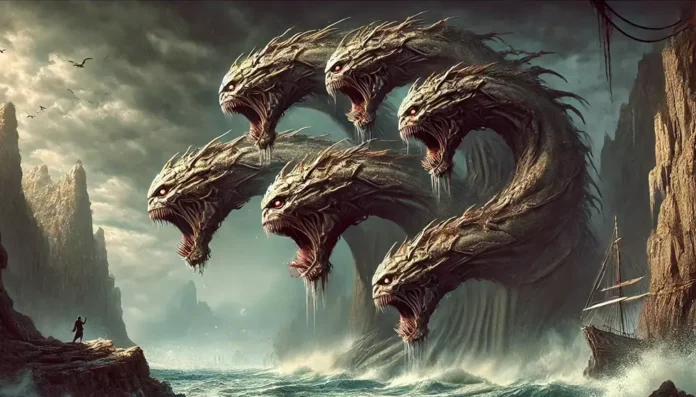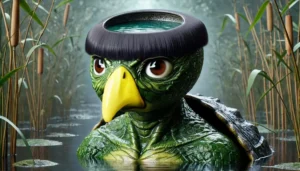Introduction
Scylla is one of Greek mythology’s most terrifying sea creatures, infamous for her monstrous form and appetite for destruction. Stationed alongside Charybdis, she guarded the narrow Strait of Messina, making her an unavoidable danger for ancient sailors. Known for her multi-headed appearance and relentless predation on passing ships, Scylla symbolizes the unavoidable perils of the sea.
In the Odyssey, she’s an insurmountable threat even the cunning Odysseus can barely escape. To the ancient Greeks, Scylla wasn’t just a myth—she was the embodiment of nature’s unpredictable and destructive force.
“From her grisly den, Scylla reaches out, snatching six men at a time in her dreadful jaws.” – Homer, The Odyssey
Scylla’s impact goes beyond Greek myth; she’s become a universal icon of danger lurking just below the surface. Her story teaches that not every peril can be conquered; sometimes, survival itself is the only victory. Scylla reminds us of nature’s ferocity and the thin line between heroism and helplessness.
History/Origin
Scylla’s origins lie in ancient Greek seafaring culture, where she was more than just a story—she was a way of explaining the real dangers of open waters. Homer’s Odyssey provides one of the earliest accounts, describing Scylla as a hideous creature with twelve tentacle-like legs and six heads, each armed with razor-sharp teeth. In her cave, she waits for sailors to pass, snatching them up to satisfy her endless hunger. Ancient Greeks, who relied heavily on sea travel, saw Scylla as a personification of the unpredictable and deadly threats faced in narrow straits and turbulent waters.
The Roman poet Ovid added to her story in Metamorphoses, explaining Scylla’s transformation from a beautiful nymph into a monster. According to Ovid, the jealous sorceress Circe cursed Scylla, turning her into a terrifying beast as punishment. This story adds a layer of tragedy, showing Scylla as a victim of divine whims, cursed to dwell forever as a horror to those who dared sail too close.
“Transformed by envy and spite, the fair Scylla became a horror to all.” – Ovid, Metamorphoses
Another telling traces her lineage to Phorcys and Ceto, primordial sea deities, connecting her to the ancient, untamed powers of the ocean itself. Whether as a cursed beauty or born of ancient powers, Scylla embodies the dangerous unpredictability of the sea.
Name Meaning
The name “Scylla” carries significant meaning, derived from ancient Greek roots that suggest themes of violence and predation. Some sources trace it to the Greek word “skylax,” meaning “puppy” or “young dog,” which is ironic given her monstrous form but may hint at her snapping jaws, resembling a pack of attacking hounds. Others link it to “skyllō,” which means “to tear” or “to rend,” describing her role as a ferocious predator.
In Greek mythology, names often reflect a creature’s nature, and Scylla’s name is no exception. Her designation captures her relentless, violent appetite and her singular focus on destruction. This name evokes fear, a reminder that the creature lurking in the Strait of Messina is more than a myth; she’s a force of nature, waiting to unleash chaos on those who venture too close.
Background Story
Scylla’s transformation story is one of beauty turned to horror. Originally a lovely sea nymph, Scylla drew the attention of several gods, including the sea god Glaucus. Envious of Scylla’s allure, the sorceress Circe cursed her, turning her into a monstrous creature with six vicious heads and twelve tentacle-like limbs. This transformation condemned Scylla to a life of isolation in a cliffside cave, where she attacked any ship that dared pass through her domain in the Strait of Messina.

In Homer’s Odyssey, Scylla’s role is highlighted as a trial for Odysseus, whose crew falls victim to her monstrous jaws. Here, Scylla’s presence serves as an obstacle that no hero can fully overcome, symbolizing unavoidable danger. Odysseus’s encounter with Scylla captures the myth’s emphasis on the challenges of fate and the inevitability of loss.
“Six men she seized, writhing, gasping for breath, and her jaws swallowed them whole.” – Homer, The Odyssey
Cultural Impact
Scylla’s impact extends beyond her appearances in ancient texts. As a symbol of uncontrollable danger, she represents the unpredictable forces of the sea, inspiring reverence and fear among sailors and storytellers alike. The term “between Scylla and Charybdis” became a common expression for choosing between two equally perilous situations, illustrating her enduring presence in cultural expressions.
Scylla also appears in ancient art, from pottery to mosaics, where artists captured her hybrid form, often with a mix of beauty and terror. Her image has inspired various adaptations, becoming a fixture in seafaring cultures as a reminder of the power of the natural world.
Similar Beasts
Scylla’s story echoes across mythologies. In Japanese lore, Umibozu embodies the terror of the open sea, appearing as a mysterious ocean creature that capsizes boats, similar to how Scylla threatens sailors. Norse mythology’s Jormungandr, a giant sea serpent, also symbolizes maritime peril. Both creatures represent forces that sailors must respect and fear.
In Western mythology, sirens also serve as a counterpart to Scylla. Sirens lure sailors with beauty, much like Scylla’s former nymph form, but both lead to destruction. Scylla’s transformation from a beautiful nymph to a vicious monster parallels how sirens shift from alluring to deadly.
Religion and Ritual
In ancient Greece, where seafaring was integral to life, sailors would offer sacrifices and prayers to the gods for safe passage, hoping to avoid encounters with beings like Scylla. Offerings to Poseidon, god of the sea, were particularly common. It is believed that sacrifices made at sea or on the shores were meant to placate not only Poseidon but also monstrous sea entities under his domain, such as Scylla.
Rituals aimed at appeasing marine deities reflect the deep respect ancient Greeks had for the ocean and its dangers. Scylla’s myth likely contributed to these practices, serving as a reminder of the perils that lurked beyond familiar waters.
Scientific or Rational Explanations
While Scylla remains a creature of myth, historians and scientists suggest that her legend could be rooted in natural phenomena. The turbulent waters of the Strait of Messina, where she and Charybdis supposedly dwelled, are known for powerful whirlpools and eddies that could easily endanger ships. These natural occurrences might have inspired myths of monstrous sea creatures inhabiting the strait.
Additionally, some speculate that Scylla’s multi-headed description could stem from sightings of multiple sea animals surfacing at once, such as seals or dolphins, which could appear as a single, many-headed entity in the dim light or rough seas.
Modern Cultural References
Scylla’s influence extends into modern literature, art, and popular culture, where she continues to appear as a symbol of natural fury and unavoidable peril. Here are some examples:
Rick Riordan’s Percy Jackson & the Olympians – In this popular series, Scylla makes an appearance as an obstacle for young demigods, staying true to her role as a fierce monster of the sea.
Assassin’s Creed Odyssey (Video Game) – Players encounter a setting inspired by Greek myths, including Scylla, as they navigate the perils of the ancient Greek world.
The Sea of Monsters (Film) – Adapted from Rick Riordan’s book, this film depicts Scylla as a terrifying creature, bringing Greek mythology to the screen for younger audiences.
Magic: The Gathering (Card Game) – Scylla-inspired creatures appear in this card game, reflecting her role as an untamable force that can wreak havoc on opponents.
The Last Odyssey by James Rollins (Novel) – Scylla is referenced as part of a modern adventure thriller that blends ancient mythology with contemporary settings.
Dante’s Divine Comedy – Although not a modern text, Dante’s epic poem features Scylla as a historical reference, showing her enduring presence in literature beyond Greek mythology.
Age of Mythology (Video Game) – As part of this mythology-inspired game, Scylla represents a powerful creature that players can encounter, furthering her legacy in interactive media.
The Witcher series (Books and Games) – Scylla-inspired creatures appear as part of the dangerous world, showing how her myth has influenced other fantasy worlds.
Clash of the Titans (Film) – While not directly featuring Scylla, this film’s focus on mythical beasts and oceanic threats draws inspiration from creatures like her, highlighting the dangers faced by ancient heroes.
Jason and the Argonauts (TV Miniseries) – This adaptation brings Scylla into a visual format, blending myth with modern storytelling.
“And in her darkened waters, Charybdis churns, while Scylla waits with open jaws.” – Anonymous Modern Adaptation
Conclusion
Scylla endures as a potent symbol of the dangers hidden within nature’s beauty and the unpredictability of the sea. Her myth reflects the fears and challenges of seafaring cultures, blending the awe of the ocean with the terror of its hidden threats. In modern culture, Scylla appears as both a monstrous obstacle and a fascinating subject, highlighting humanity’s fascination with tales of danger and survival. As a figure of transformation and power, she reminds us of the thin line between beauty and terror, and how myth continues to echo the mysteries of the natural world.










